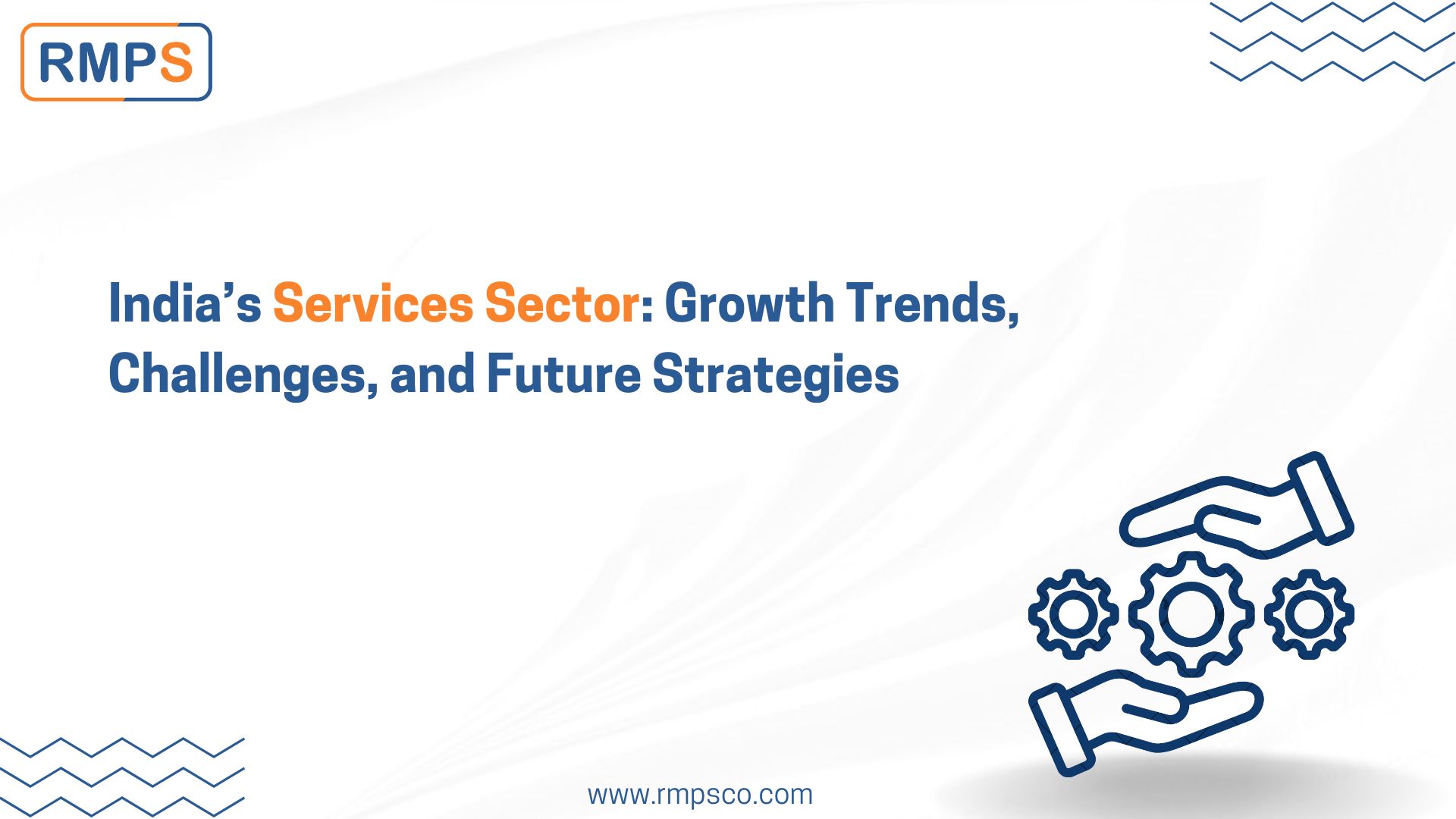
The services sector continues to be the driving force behind India’s economic growth, contributing significantly to GDP, employment, and exports. Despite global economic uncertainties, India’s services exports have expanded, and digital transformation is reshaping multiple industries. However, challenges such as supply chain disruptions, global trade protectionism, and regulatory bottlenecks remain key concerns.
This blog highlights India’s services sector performance, emerging trends, and strategic priorities for sustaining long-term growth.
1. Services Sector: The Backbone of India’s Economy
- Contribution to GDP: The services sector accounted for 55% of India’s Gross Value Added (GVA) in FY25, up from 50.6% in FY14.
- Employment Share: Employs 30% of the workforce, making it a key driver of job creation.
- Global Positioning: India ranks seventh in global services exports, holding a 4.3% market share.

Key Takeaways:
- India’s services sector remains resilient, with strong domestic and export-driven growth.
- The sector is evolving, with digital transformation and “servicification” of industries boosting efficiency.
2. India’s Growing Influence in Global Services Trade
- Services exports grew at 11% annually (FY14-FY23), with IT and business services contributing 70% of total exports.
- India’s services export share (4.3%) is rising, reducing dependence on merchandise exports.
- Trade uncertainties and global protectionism remain challenges for sustained export growth.
Key Takeaways:
- India’s services exports are growing faster than merchandise exports, enhancing trade resilience.
- Diversification of service offerings is crucial to reduce dependency on IT and business services alone.
3. Sub-Sector Performance: Key Growth Drivers
Technology and Digital Services: Leading the Transformation
- IT & ITeS sector revenue reached USD 254 billion in FY24, with USD 200 billion in exports.
- Global Capability Centers (GCCs) in India increased from 1,430 (FY19) to 1,700+ (FY24), employing 1.9 million professionals.
- AI & Machine Learning adoption is transforming fintech, telecom, and e-commerce industries.
Key Takeaways:
- India remains a global leader in IT & digital services, attracting high-value projects.
- AI, automation, and digital platforms will define the future of IT services.
4. Infrastructure-Led Growth in Transport & Logistics
Railways: Modernization & Capacity Expansion
- Indian Railways’ passenger traffic grew by 8% YoY in FY24, with freight revenue rising by 5.2%.
- Vande Bharat trains and Dedicated Freight Corridors (DFCs) are enhancing efficiency.
- E-ticketing penetration reached 86%, reducing operational inefficiencies.
Key Takeaways:
- Railway modernization is improving connectivity and freight efficiency.
- High-speed rail and PPP investments are crucial for future expansion.
Aviation: India’s Fastest-Growing Transport Segment
- India placed the largest aircraft orders globally in FY24, strengthening air connectivity.
- Air passenger traffic rebounded strongly post-pandemic, reaching 30+ crore in FY24.
- Expansion of MRO (Maintenance, Repair & Overhaul) is reducing costs for airlines.
Key Takeaways:
- India is one of the fastest-growing aviation markets, requiring investment in airport infrastructure.
- MRO and aircraft leasing reforms will improve operational efficiency.
5. Digital Commerce and Telecom Advancements
ONDC: Open Network for Digital Commerce
- ONDC recorded 14 million transactions (Nov 2024) across 1,100+ cities.
- 7 lakh+ sellers and 5.45 lakh drivers onboarded, creating a unified digital commerce ecosystem.
- Integrating fintech and supply chain solutions is driving e-commerce growth.
Key Takeaways:
- ONDC is revolutionizing e-commerce by fostering MSME participation.
- Scalability of digital commerce will drive long-term economic growth.
6. Conclusion: Strategic Priorities for the Services Sector
India’s services sector remains the main driver of economic growth, with digital transformation, infrastructure expansion, and global integration unlocking new opportunities.
Key Focus Areas for Future Growth:
- Expand High-Value Services: Strengthen IT, fintech, and healthcare services.
- Enhance Digital & Financial Inclusion: Leverage fintech and e-commerce for MSME growth.
- Invest in Sustainable Tourism & Infrastructure: Improve logistics and hospitality sectors.
- Strengthen Services Export Competitiveness: Reduce trade barriers and diversify markets.
- Leverage AI & Emerging Tech: Drive innovation in telecom, logistics, and digital platforms.
India’s services sector is at a critical inflection point, and strategic investments, policy reforms, and digital adoption will determine long-term global competitiveness.
LinkedIn Link : RMPS Profile
This article is only a knowledge-sharing initiative and is based on the Relevant Provisions as applicable and as per the information existing at the time of the preparation. In no event, RMPS & Co. or the Author or any other persons be liable for any direct and indirect result from this Article or any inadvertent omission of the provisions, update, etc if any.
Published on: February 1, 2025
